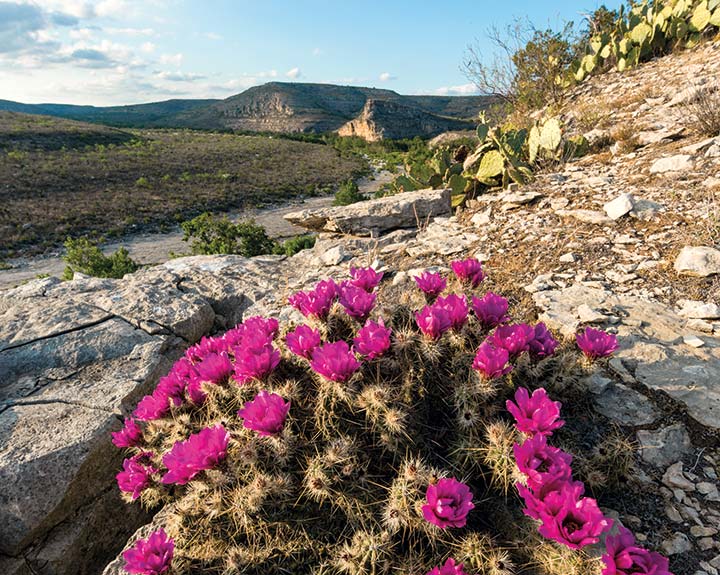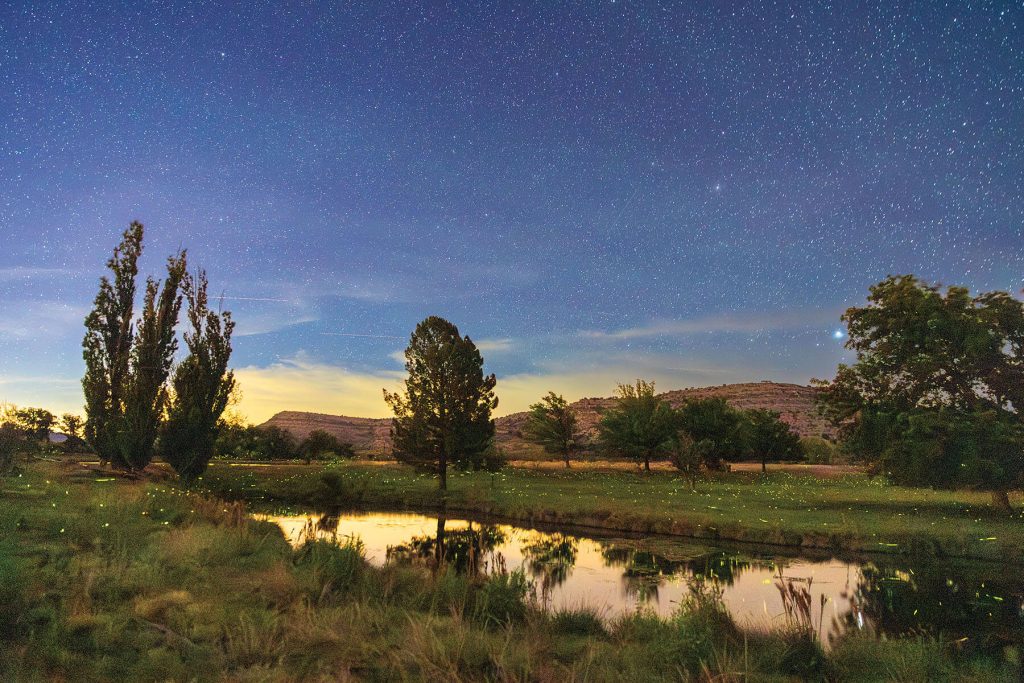
Texas bluebonnets envelop Ellis County. (Photo © Laura Vu)
Nothing says spring in Texas like bluebonnets, paintbrushes, and other familiar wildflowers. Some years these blooms merely whisper the season’s arrival, their voices muted by drought or unseasonal temperatures, but other times they trumpet the news with great swaths of vivid color as far as the eye can see.
This spring promises to be closer to a shout than a whisper, but either way there will be wildflowers somewhere, sometime. Nature is nothing if not resilient and, this being Texas, she seems capable of handling more than we might expect. In our annual wildflower drive article, we endeavor to send you places where you’ll see the beauty of wildflowers and find plenty of other diversions to make for a great trip. We also try to cover parts of the state you might not think of when it comes to wildflowers and where you may sometimes have to work a bit harder for that photo-worthy payoff.
That said, we encourage you to enjoy our state’s better-known, tried-and-true wildflower locations—Brenham and Chappell Hill in Washington County; the Hill Country from Austin to Fredericksburg to the Highland Lakes, Llano, Burnet, Bandera, and beyond; East Texas around Ennis, Athens, and Tyler; and upper South Texas. But you don’t have to stop there.
Watch this page as we share drives to lesser-known places with great potential for beautiful photographs and wonderful memories.
Fort Davis/Alpine

Illustration by Kristine Lombardi
More Info:
Fort Davis Chamber of Commerce, 800/524-3015.
Davis Mountains State Park, 432/426-3337.
Davis Mountains Preserve, 432/426-2390; keyword search at www.nature.org.
Alpine, call 800/561-3712.
You won’t find many of the usual spring suspects here, but the Fort Davis area offers unusual species and incredible scenery overall, and wildflowers really pop during the rains of late summer. Start in Fort Davis with its 75-mile scenic loop, heading west on Texas 118 toward McDonald Observatory. Stop in at Davis Mountains State Park to see scarlet bouvardia, littleleaf leadtree, trompillo, sumac, Apache plume, tree cholla, Torrey yucca, catclaw acacia, and agarita on the park’s scenic driving loop or 12 miles of hiking trails.
Back on Texas 118, Havard agave become abundant as you wind higher. At the Lawrence E. Wood roadside park, access the Nature Conservancy Davis Mountains Preserve’s 2.5-mile Madera Canyon Trail. The Davis Mountains are a “sky island” 5,000 feet above the Chihuahuan Desert, populated by distinctive plants and animals. The region features rare plants, including the Livermore sandwort.

A splash of strawberry cactus at Devil’s River. (Photo © Jerod Foster)
From Texas 118, turn left on Texas 166. Look for agaves, beargrass, and purple feather dalea and catch magnificent views of Sawtooth Mountain. The landscape drops and grows more arid, with ocotillos, evergreen sumac, agarita, and yuccas. Point of Rocks picnic area abuts an enormous pile of rocks dotted with Mexican buckeye, flameleaf sumac, and scarlet bouvardia. At Texas 17, turn right toward Marfa, through the Marfa grasslands and past Paisano Peak, center of a large volcanic caldera. From Marfa take US 67/90 over to Alpine. You’ll pass the viewing area for the famous Marfa Lights; if you want to try your luck, spend the night at Alpine’s stylish Maverick Inn motor court or another of the area’s storied lodgings.
Take Texas 118 northwest back to Fort Davis, motoring through grasslands where you may spy yellow bladderpods, white-flowered peppergrass, and purple verbena, says Patricia Manning, who until her recent retirement ran the greenhouses for the Biology Department at Sul Ross State University. Later, when it’s mealtime, try a juicy half-pound burger at Fort Davis Drug Store’s old-fashioned soda counter, or a panini at the Hotel Limpia’s Blue Mountain Bistro, which serves fine cuisine like beef Bourguignon for dinner. Bunk at the historic Limpia, Western-themed Harvard Hotel, or circa-1935 restored Stone Village Tourist Camp, all right in town.
More Info:
Brazosport Convention & Visitors Council, 979/285-2501
Mid-Coast National Wildlife Refuges, 979/964-4011.
Brazoria County Parks, 979/864-1541 (979/233-1461
for Quintana Beach).
Brazosport Area
After a hearty breakfast at Asiel’s Restaurant in Lake Jackson (famous for donut burgers and bacon nights), head northeast on FM 2004 to Brazoria National Wildlife Refuge, where a driving tour serves up sedges, rushes, and cattails along with evening primrose, coreopsis, paintbrush, Indian blanket, and spider and rain lilies. The Discovery Center’s walking path offers a close look at spiderworts and water lilies.

Illustration by Kristin Lombardi
Return to Lake Jackson on FM 2004, passing coreopsis and coralbean, then take Texas 288 north, then FM 1462 west and FM 762 north to Brazos Bend State Park for an astonishing variety of wildflowers: ten petal anemone, Texas frogfruit, coreopsis, Mexican hat, plains wild indigo, wine cup, and showy primrose. Park interpreter Sharon Hanzik says spectacular spider lilies are found in wet areas at the west end of the park and irises in swampy areas on Hale Lake Road.
Continue on 1462 and take Texas 36 south through Brazoria, then FM 2611 to the San Bernard National Wildlife Refuge. Irises and water lilies bloom along the Bobcat Woods walking trail (come prepared for mosquitoes!) and the three-mile Moccasin Pond driving trail, part of a 9.4-mile driving tour of the refuge.
Midway between the two refuges just a couple of blocks off FM 2004 in Lake Jackson, the Gulf Coast Bird Observatory harbors anemone, coneflower, coral honeysuckle, curly clematis, and narrowleaf sunflower. On the Observatory’s coastal property, next to the town hall in Quintana, find bluebonnet, coralbean, gaillardia, lantana, spotted beebalm, and more. Volunteers staff that site in April to help visitors locate migrating song birds and will also help identify wildflowers.
If you want to linger, Quintana Beach County Park rents cabins with views of the beach and wildflowers such as coreopsis and lantana in the brush-covered dunes. Nearby in Surfside, the Red Snapper Inn serves a variety of dishes made with snapper that were swimming in the Gulf mere hours before.
Bastrop Area

Illustration by Kristine Lombardi
The September 2011 fire that devastated Bastrop State Park’s loblolly pines created open space for wildflowers, and botanist Bill Carr says the park’s bounty last year included red firewheel, spotted horsemint, Carolina larkspur, yellow primroses, lazy daisies, Drummond’s phlox, sensitive briar, and Georgia rockrose. Open areas also hold plants unique to Texas such as Brazos-mint, stemless spiderwort, broadleaf snakecotton, and sandyland bluebonnets, the same genus but a separate species from the well-known Texas bluebonnet. Drive Park Road 1A and stop at the scenic overlook at the highest point in the park for nice views and several trails to explore. Park Road 1C, stretching 10 miles between Bastrop and Buescher state parks, is experiencing post-burn natural revegetation and offers many wildflowers. Carr expects a good season thanks to fall rains. Ranger-guided hikes to new park property containing sandy meadows offer the best
wildflower viewing.
Around Bastrop, look for maroon blanket flower or Indian blanket, a plant adapted to this sandy soil, as well as tall prairie larkspur, brilliant annual phlox, bright cowpen daisies, and Indian paintbrushes. Stay at the park’s CCC-built cabins or campgrounds to see wildflowers at their best in early-morning light.
Just outside the park on Texas 21, enjoy spring weather and a thick, juicy burger on the deck at Roadhouse restaurant, which also serves salads, steaks, and chicken sandwiches.
West of town, explore the Lower Colorado River Authority’s McKinney Roughs Nature Park on 18 miles of hiking and equestrian trails. Park naturalist Nicholas Cowey says that on Buckeye, Roadrunner, and Pecan Bottom trails, you’ll find delicate baby blue eyes, Turk’s cap, and showy rusty blackhaw trees. Open fields along the Ridge, Bluff, and Pine Ridge trails contain coreopsis, Mexican hats, brown-eyed Susan, and blue curls. South of the overflow parking lot, bizarre-looking swanflower blooms and patches of sandyland bluebonnets brighten the south side of Bobcat Ridge Trail. There’s no need to walk far to see wildflowers in the gardens near the visitor’s center.
Along area roads, coreopsis, black-eyed Susans, phlox, Indian paintbrush, and bluebonnets abound. Find more sandyland bluebonnets by taking Texas 21 west of town; turn on County Road 81, which turns into County Road 82 (Shiloh Road), Cowey’s favorite spot.
Extend your wildflower watching by staying overnight at Hyatt Regency Lost Pines Resort & Spa, adjacent to McKinney Roughs (and connected via trails), or in town.
East Texas

Illustration by Kristine Lombardi
Start this drive in Nacogdoches on the north end of Stephen F. Austin State University’s campus at its 42-acre Pineywoods Native Plant Center, home to a variety of trees and rare and endangered nativessuch as Neches River rose mallow, Winkler’s white firewheel, and
Texas trailing phlox. More than 100 species inhabit The Lady Bird Johnson Wildflower Demonstration Garden, including prairie flowerslike gayfeather, bush pea, goldenrod, and coneflowers. The Center’s two miles of trails are wheelchair accessible.
For lunch or dinner, stop at Auntie Pasta’s restaurant, housed in what was the first refrigerated warehouse west of the Mississippi. Choose from gourmet pizzas, 10-layer lasagna baked daily (go early before it’s gone!), and other traditional Italian dishes and desserts, as well as sandwiches and salads.
Take Texas 7 southwest toward Crockett through the Davy Crockett National Forest. At Ratcliff, turn right onto FM 227 (possible closures this spring due to bridge construction), which is covered in wildflowers in good years, according to U.S. Forest Service officials. When FM 227 hits Texas 21, turn right and after about six miles look for Forest Road 511. This will take you to FR 511-A, a short unpaved road to the Neches Bluff Overlook, at the northern end of the 20-mile 4C Trail. Take a short walk on the trail to see hairy-jointed meadow parsnip and common East Texas wildflowers.
Return to Texas 21 and head southwest to Crockett, then turn north on US 287 toward Palestine. On Dogwood Trails weekends—March 20-22 and 27-29, and April 3-5 this year—enjoy a variety of activities revolving around viewing the long-lasting, showy white blooms in 200-acre Davey Dogwood Park and surrounding area.
From Palestine, take US 84 east toward Rusk, stopping at Maydelle Country Wines on County Road 2108 to taste wines made from blackberries, grapefruits, and peaches as well as locally grown grapes—and root beer for the kids. Follow US 69 south to Alto, where you catch Texas 21 back to Nacogdoches. Along these roads you’ll find bluebonnets, paintbrushes, dogwoods, swamp sunflowers, wine cups, Indian blankets, wisteria, and redbuds.
Stay in the main lodge or cabins scattered on pine-covered hills at Pine Creek Country Inn, 10 miles west of Nacogdoches on FM 2782.








